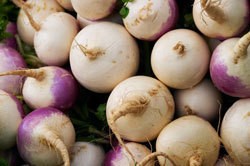Select small to medium, firm turnips or parsnips that are tender and have a mild flavor. Look for crisp green tops as an indicator of freshness. Turnips should be firm without a lot of roots. Parsnips should be firm with no soft spots or cuts. Larger parsnips tend to have woody cores. Both vegetables will have the best flavor in the early spring after a winter of frosts. If growing your own, keep them in the ground as late in the season as possible. Frost will only improve their flavor.
Cut off tops, wash, peel and cut into 1/2 inch cubes.
Water-blanch for 2 minutes or steam-blanch for 3 minutes. Cool promptly and drain. Turnips and parsnips can also be fully cooked before freezing.
Pack blanched or fully cooked turnips or parsnips in suitable containers, leaving 1/2 inch headspace. Seal, label and freeze.
Freezer containers should be moisture and vapor resistant and should not be prone to cracking or breaking at low temperatures. Containers should provide protection against absorbing flavors or odors and should be easy to label. Suitable packaging for freezing turnips and parsnips includes freezer-grade plastic bags, rigid plastic containers, glass containers, heavy-duty aluminum foil and foil containers.
10 to 12 months at 0ºF.
Add frozen turnip or parsnip cubes directly to dishes while cooking.
You can keep turnips and parsnips frozen right in the garden all winter long. You can protect them from alternate freezing and thawing in the fall, by covering them with a thin layer of mulch. Once temperatures drop below freezing, push the mulch aside and let them freeze in the ground. Then recover them with a thicker layer of mulch so they stay frozen. Dig them up and thaw in a cool place as you need them.
Store unwashed in perforated plastic bags for 7 to 10 days. They can also both be stored at room temperature for nearly as long.

Add your voice! Click below to comment. ThriftyFun is powered by your wisdom!